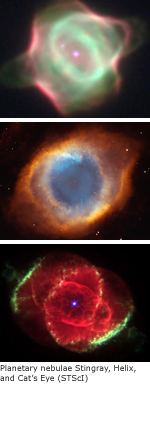 |
 |
 |
 |
 |

White Dwarf Stars and the Age of the Galaxy is
designed to facilitate collaborative research on white dwarfs, and to offer
curriculum and training opportunities to teachers of students grades 9-12.
The work is a collaboration of researchers from The University of Texas at Austin,
The University of Arizona, The University of Delaware, Florida Institute of Technology, and
US Naval Observatory, Flagstaff.
|
|
|
 |
|

|
 |
White Dwarf Stars
Like living things, stars are born, live long
lives, then die. On earth, we find the
remains of life forms that lived
millions of years ago. Replacing once
living tissue, minerals and crystals preserve
characteristics of former life
forms as fossils. After most stars complete
their lives, shining with the energy released from
nuclear fusion, they condense and settle into hot,
superdense spheres approximately the size of Earth - a
white dwarf. Since the number of "fossilized
stars" is almost as great as the number of living stars,
white dwarfs are abundant in our
Galaxy.
Although they are abundant, as they cool, white dwarfs fade and become
difficult to detect with telescopes. But they
cool on a schedule dictated by their mass, much
like a hot iron cools.
Slowing the cooling, white dwarfs have thin, insulating blankets on their
surfaces - their atmospheres. Still, the cooler the white dwarf, the older it is. By
calculating the temperatures of many white dwarfs, astronomers can date our galaxy, the Milky Way, to
constrain theoretical models of stellar evolution
and galactic evolution.
|
 |
 |

